Nine Treasures of Japan You NEED to See. Here’s How!
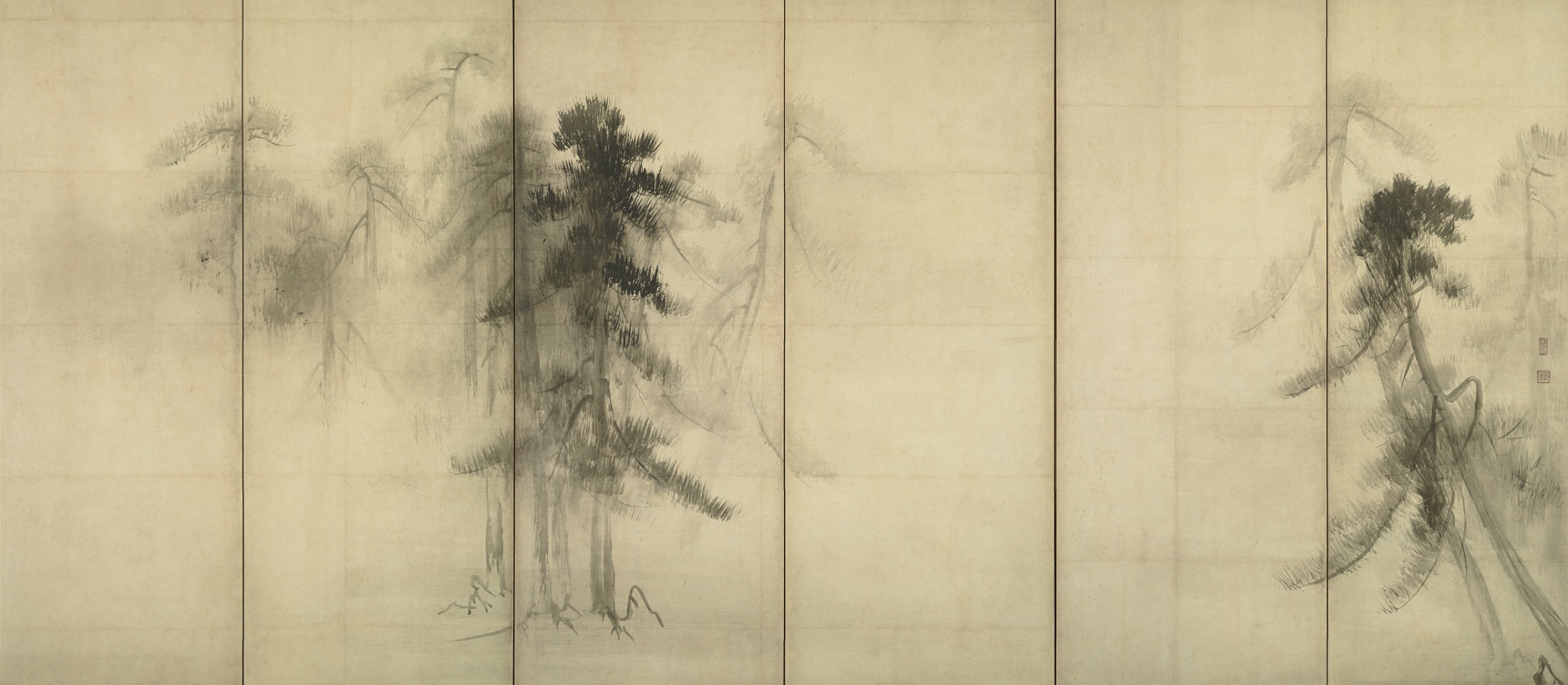
How is Cultural Heritage Preserved in Japan?

#1 Kujaku Myoo (Peacock deity), color on silk, 12th c., Heian period.
For well over a thousand years, Japan has had institutions to safeguard the country's artworks, and historical artifacts. An early example is the Shosoin repository, built in the eighth century on the grounds of the Todaiji temple in Nara, where even today many ancient sutras and other rare and precious objects are stored. Treasures of all kinds, including paintings and swords, were also kept under the protection of temples and shrines, or passed down within aristocratic or samurai families. But fires, natural disasters and war took their toll, and across the centuries, many objects of historical and cultural significance were inevitably lost.
What's a 'National Treasure?'
Today, a large number of the nation's most important treasures have been transferred to public and private museums, where they can be safeguarded and more easily shared with the public. The Tokyo National Museum, a complex of several grand buildings adjacent to Tokyo's famed Ueno Park, was the first modern museum in Japan and traces its history to a government exhibition held in 1872. It is a key part of Japan's modern system to preserve and protect, which classifies the nation's most important buildings, artworks and artifacts as "National Treasures."
This year, to celebrate its 150th anniversary, the Tokyo National Museum will rotate onto view all 89 of their National Treasures in one unprecedented show. Titled Tokyo National Museum: Its History and National Treasures, the exhibition runs from Oct. 18 to Dec. 11, 2022. It's always worth seeking out National Treasures because they're what Japan itself regards as the best of Japanese culture. In this article, I introduce nine superlative examples of National Treasures that will be on public view during the anniversary show.
Let's start with the painting above, which depicts a deified peacock known in Japan as Kujaku Myoo, the Peacock King. Worship of this deity originated in India, where peacocks are admired not only for their beauty but also because they eat poisonous snakes and insects. In Japan, a country visited frequently by natural disasters, images of the Peacock King were used in rituals to ward off calamities such as droughts, floods and famine.
This is a beautiful and well preserved painting, full of rich color, and it clearly shows the influence of India and China in Japanese Buddhism. It is very similar in composition to paintings carried to Japan from China by Kukai, the founder of the Shingon sect of Buddhism in Japan.
#1. The Kujaku Myoo painting is on display at the Tokyo National Museum Oct. 18-Nov. 13, 2022. At other times, check the museum website or view online.
Ancient Artifacts that Still Inspire
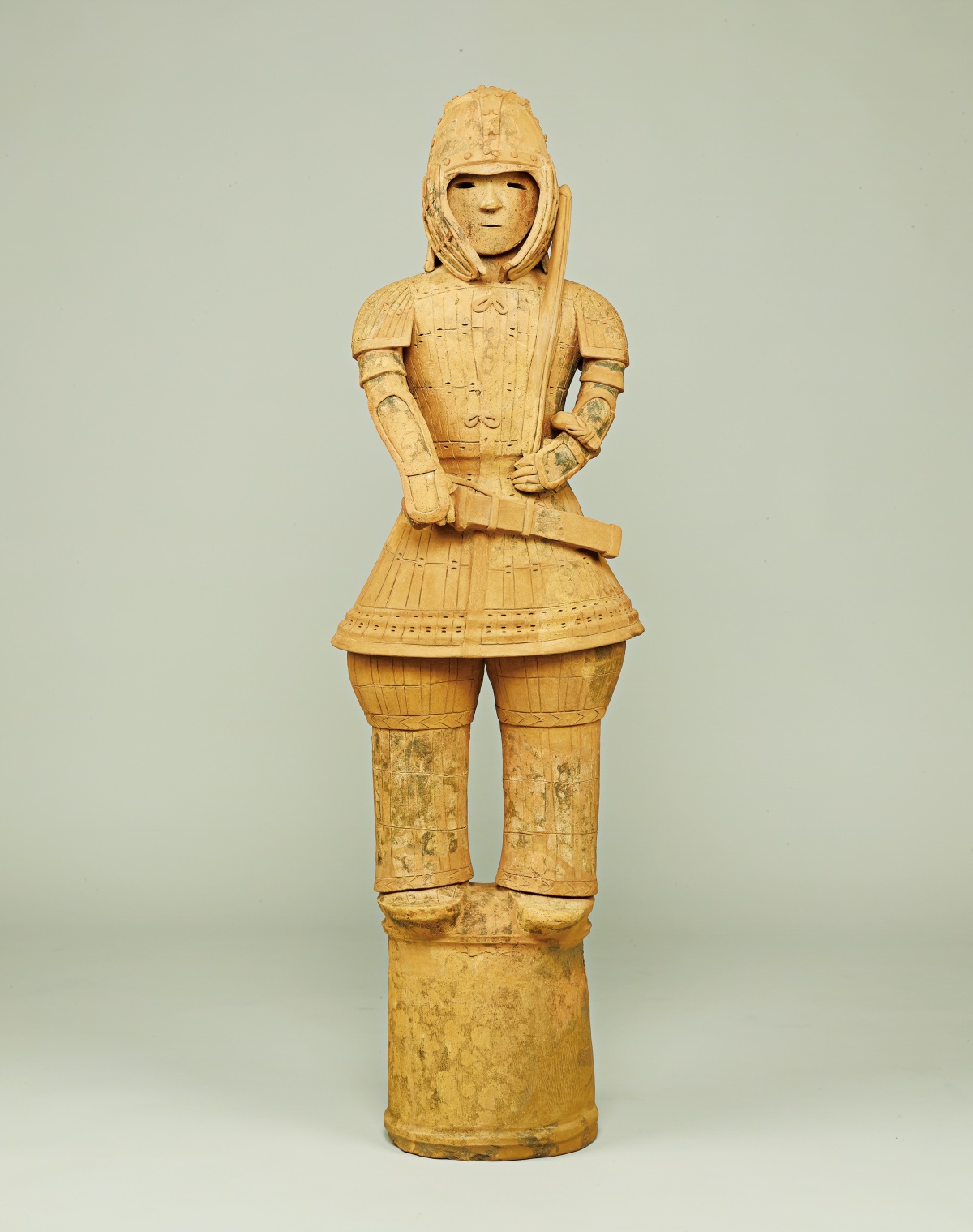
#2. Haniwa Tomb Sculpture: Warrior in Keiko Armor, 6th c. (Kofun period). Excavated from Iizuka-cho, Ota-shi, Gunma Prefecture.
How many National Treasures are there?
As of September 2022, there are 1,131 National Treasures of Japan, including buildings, sculptures, paintings, calligraphy and archeological artifacts. The oldest is the so-called "Jomon Venus," a clay female figurine that dates from the Middle Jomon period (3520–2470 BCE). The most recent is the Akasaka Palace in Tokyo, a Western-style building completed in 1909 that is currently used as a state guest house.
The regal figure above is one of the older National Treasures, a type of burial sculpture known as haniwa. Many other examples of haniwa, some representing houses or animals such as horses, monkeys and boars, have been unearthed from tumuli in several parts of Japan. But this warrior is the only haniwa to be designated as a National Treasure. Nearly life-size, standing 130 cm (over 50 inches) tall, it is of particularly high quality with an outstanding level of detail. The almond-shaped eyes lend the face a tranquil expression and the body is well balanced, suggesting the figure was produced by an accomplished artisan. Several other warrior haniwa with similar features were excavated in the same vicinity, suggesting that a center for haniwa manufacture may have existed somewhere nearby. Haniwa have been a source of fascination and inspiration for many artists, including American sculptor Isamu Noguchi.
#2. This charming haniwa tomb sculpture is on display at the Tokyo National Museum Oct. 18-Nov. 11, 2022. At other times, check the museum website or view online. A 3-minute video on YouTube shows the piece from all angles.
Courtly Masterpiece: "Drunken" Flowers
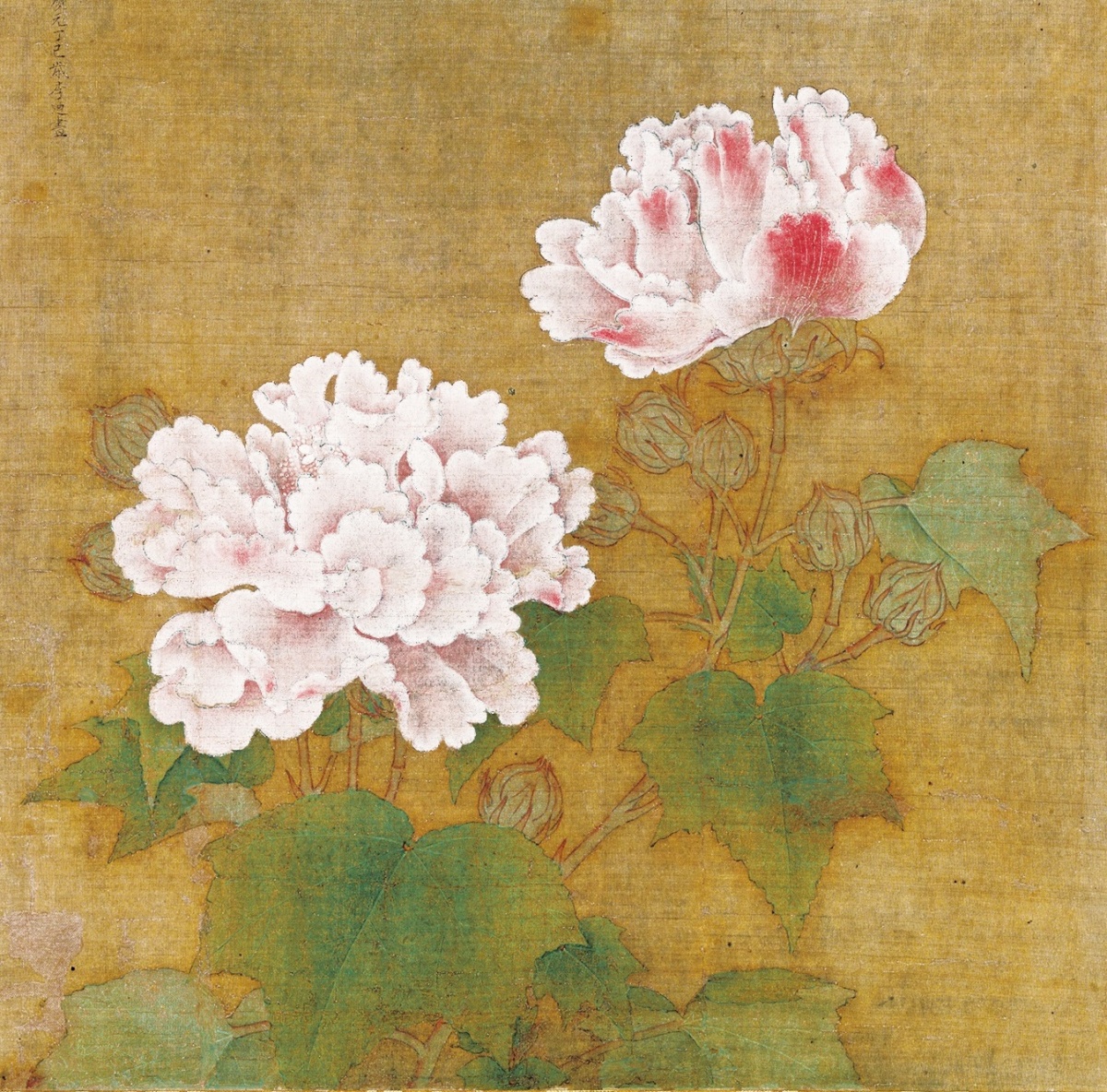
#3. Red and white cotton rose mallow (1197), color on silk. By Li Di, a Chinese painter of the Southern Song Dynasty.
Not all National Treasures of Japan are Japanese. About ten percent, ranging from ceramics and bronze works to calligraphy and manuscripts, are originally from other countries, most often China. Brought to Japan as sources of inspiration and learning, these precious objects have been carefully preserved in Japan over the ages because of their historical or artistic value. A good example is this work by Li Di, a court painter in the Imperial Painting Academy of the Chinese Southern Song dynasty who specialized in paintings of flowers, birds, and animals.
The flowers are a type of hibiscus known in English as cotton rose mallow, which are quite common in Asia, often growing wild along roadsides. I have some in my garden outside of Tokyo. The flowers open white in the morning but as the day progresses gradually turn red. For this reason, in Japan, where many people get red in the face when they drink alcohol, this flower is known as suifuyo, or “drunk cotton rose mallow.”
This charming study of garden flowers, one of a pair now mounted as hanging scrolls but believed to have originally been leaves in an album, was brought to Japan in the 15th century. It is prized not only as a masterpiece among Li Di's extant works but also as important evidence in establishing when the artist was active. An inscription on the painting indicates it was executed in the third year of the Qingyuan reign (1197), establishing that Li Di painted in the late 12th century.
#3. This Li Di masterpiece is on display at the Tokyo National Museum Oct. 18-Nov. 13, 2022. At other times, check the museum website for exhibition information or view online.
Status Symbols Flaunting Overseas Connections

#4. Earrings, 5th–6th century (Kofun period), found at Eta Funayama Tumulus, Kumamoto.
These earrings were discovered in 1873 in a burial mound in what is now Kumamoto Prefecture, part of a set of funereal items for a high-ranking person that include weapons and other military gear, bronze mirrors, and even a pair of gilt-bronze shoes. The earrings were produced sometime around the late fifth or early sixth century, a time when gold ornaments were popular among the clans that ruled in that area. It is likely that they were made not in Japan but on the Asian continent. Although this design has not been found elsewhere in Japan, a set of similar earrings with dangling chains was discovered with other artifacts of an ancient kingdom in the Goryeong region on the Korean peninsula with whom the Kumamoto clans traded. Earrings like this were rare and precious, and were most likely worn by men as status symbols to flaunt their connections with distant nations.
#4. The gold earrings above, along with other artifacts from the same burial set including swords, stirrups, cups, beads, and bronze mirrors, is on display at the Tokyo National Museum Oct. 18 - Dec. 11, 2022. For other times, check the museum website or view online.
Kyoto Like We Wish We Could See It

#5. Half of a pair of six-fold screens by Iwasa Matabei depicting scenes in and about Kyoto. Color on gold paper. Edo period (17th century)
This six-panel folding screen is a fine and very famous example of a type of genre painting known as rakuchu rakugai-zu, which provides a map-like yet somewhat fanciful view of the area in and around the city of Kyoto. The overall perspective is from overhead, but sections within the composition zoom in on fascinating details that make this screen one of those artworks that truly must be seen in person for the full effect. But if a visit to the museum simply isn't in the cards, the publicly supported e-museum allows you to view this and other important cultural properties online, with options to zoom in on images for a better look at the details.
Such paintings were made largely to communicate political power, and so give prominence to castles, residences and temples connected to prominent clans and families as well as monuments and scenic spots for flower-viewing and other outdoor activities. Yet they are also filled with images of the townspeople of Kyoto, whose customs, clothing and modes of transportation are carefully documented. There are a few Westerners among the crowds, and a scene in the lower left shows prostitutes and customers flirting openly along the streets. In total, there are well over 2,000 individuals portrayed in the two screens, from all walks of life. Based on certain details and motifs in the scenes depicted, scholars estimate that that this screen and its mate were painted around 1615.
#5. Don't forget your eyeglasses if you go to see these fascinating screens, which are on display at the Tokyo National Museum Nov. 15-Dec. 11, 2022. At other times, check the museum website or view online.
A Treasure, Anyway You Cut It

#6. Blade for a tachi (long sword), named “Mikazuki Munechika.” Heian period, 10th–12th century. Gift of Mr. Watanabe Seiichiro.
Although Japanese swords were originally made as weapons, they evolved into much more. Over time, they came to be the very symbol of the samurai and nobility and, crafted ever more beautifully, were presented as rewards or gifts of tribute. They were also regarded as sacred items, dedicated to shrines and temples. It's no surprise, therefore, that currently there are well over a hundred blades and their fittings classified as National Treasures. The example above was crafted by the master sword maker Munechika, who lived and worked in Kyoto during the mid-Heian period (794-1185). The lines are remarkably graceful, with a pronounced curvature from the tang through the center of the length but less towards the tip. It is from this form that the sword got its name, Mikazuki, which means "crescent moon." Generally referred to as the "Mikazuki Munechika," this National Treasure has a particularly storied history, passed down through the powerful Tokugawa samurai family. By long tradition, it has been counted among the Tenka Goken, the five most famous swords of Japan.
#6. The Mikazuki Munechika is on display at the Tokyo National Museum Oct. 18-Dec. 11, 2022 along with all of the other National Treasure blades and fittings in the museum's collection. That's 19 of Japan's top swords in one exhibition, with special lighting and displays that highlight the details enthusiasts look for, such as the swirling forging patterns in the steel. At other times, check the museum's website or view online.
Groundbreaking Representation
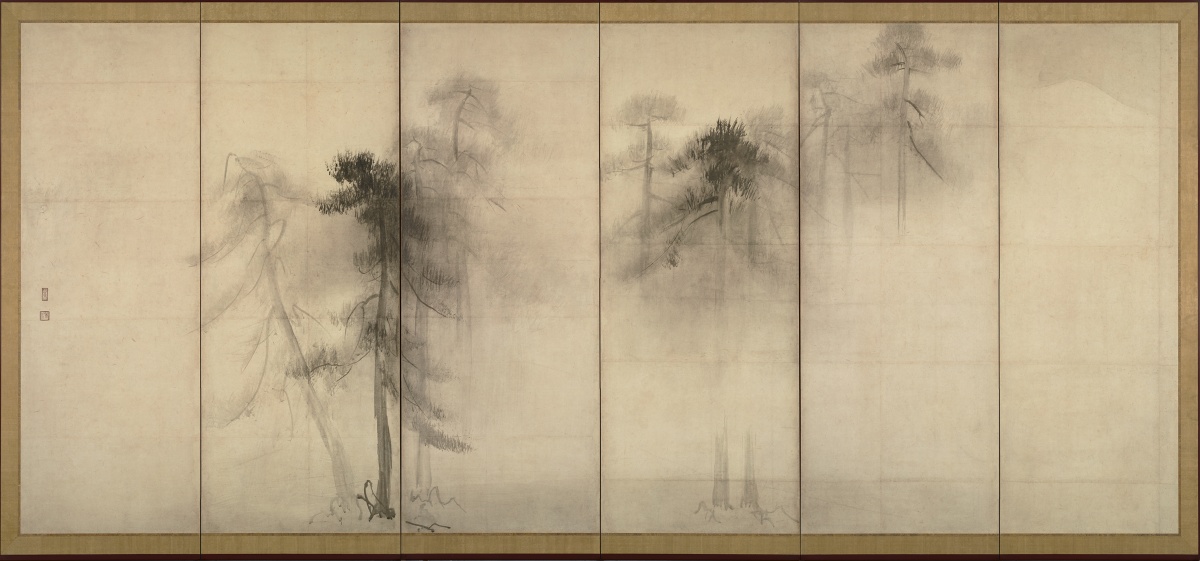
#7. The left screen of a pair of folding screens depicting a pine forest in mist, painted by Hasegawa Tohaku (1539–1610). The right screen is pictured at the top of this article.
This screen is half of a pair of six-panel folding screens by the artist Hasegawa Tohaku, one of the foremost painters of the Azuchi-Momoyama period. This amazing work, which depicts pine trees in a deep mist, has been described not only as Tohaku’s personal masterpiece, but also as the very pinnacle of Japanese ink painting. And yet a well-accepted theory has it that this work was merely a study, perhaps made while planning out a painting for a temple or other location.
Although based on Chinese ideas of ink painting, creating such a large work in monochrome ink-wash was a Japanese innovation. Working only with different shades of ink, and the masterful command of the empty space, Tohaku created a sense of endless depth and mystery. Standing in front of the screens, you can feel as if you could actually step into the forest, your skin chilled and damp from the mist swirling around you.
#7. The two Pine Trees in Mist screens are on display at the Tokyo National Museum Oct. 18-30, 2022. At other times, check the museum website or view online.
Who Says a Tool Box Needs to be Boring?
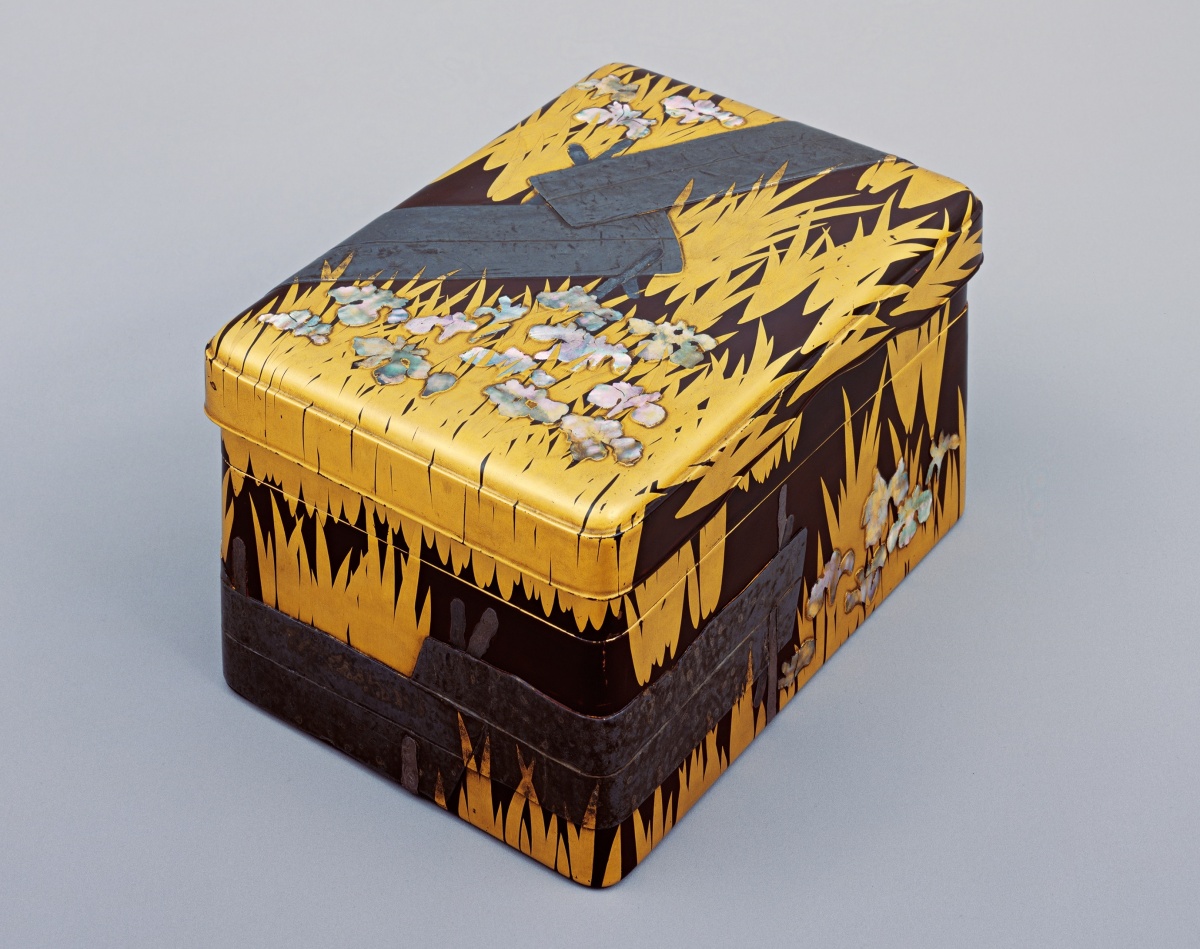
#8. Lacquer and gold writing box decorated with "Eight Bridges" theme made by Ogata Korin. Edo period (18th c.)
In Japan, writing not only well but beautifully has long been regarded as a key accomplishment for any cultured person. This was particularly true in previous centuries when courtship, friendship, business, and even governmental matters were conducted via hand-brushed poetry. Wealthy people would commission luxurious tools for writing that may well have been used every day. This finely crafted and extravagantly decorated lacquerware work is actually a two-tiered writing box. The upper tier is divided into compartments to hold an inkstone, water dropper and other calligraphy tools, while the lower tier was used for storing paper.
Why does an item designed for practical use now rank as a National Treasure? In large part, because it was designed by Ogata Korin (1658-1716), a famous artist of the Rinpa School, a style of painting that combined highly original designs abstracted from nature with allusions to classical literature. The design of plank bridges among iris blooms references a place called Yatsuhashi, meaning "Eight Bridges," that is described in the Tales of Ise, a famous collection of waka poems and stories.
The surface of the wooden box was coated with black lacquer then decorated with gold makie to represent the leaves and reeds, and inlaid with pieces of abalone shells to represent the iris blossoms. The bold contrast in color is typical of Korin's compositions, as is the shifting perspective, in which the picture on the lid is seen from above and to one side, while the plank bridge seems to be viewed from directly overhead.
#8. This luxurious writing box designed by Korin is on display at the Tokyo National Museum Nov. 15-Dec. 11, 2022. At other times, check the museum website or view online.
Door Art, of the Noblest Kind
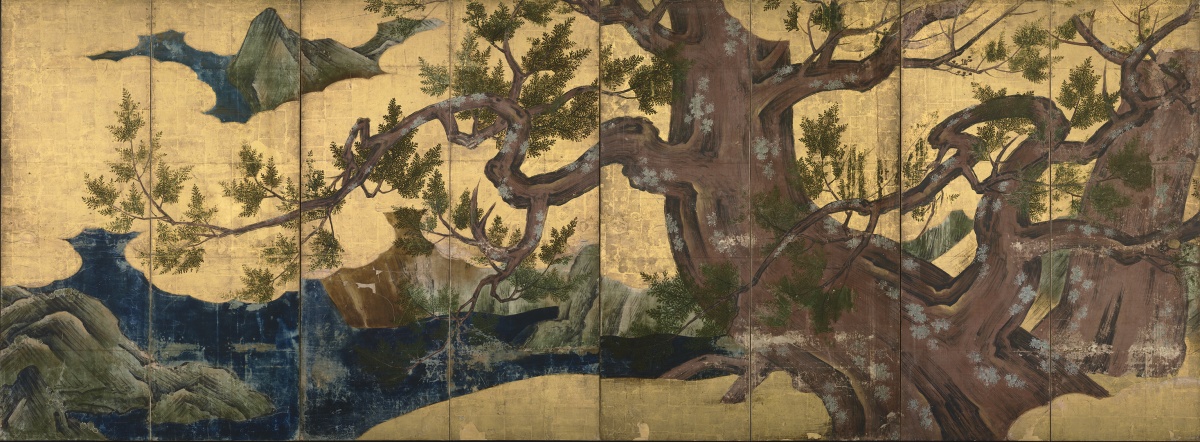
#9. Cypress tree by Kano Eitoku. Pair of four-fold screens, color and gold leaf on paper, dated 1590 (Azuchi-Momoyama period)
This impressive painting is representative of the Azuchi-Momoyama period (1574–1600), when powerful and wealthy samurai supported a flourishing of opulent culture among the warrior class. It depicts a magnificent cypress tree with a massive trunk and sprawling branches, superimposed on a background of gold-leaf clouds that affords only glimpses of rocks and sea. It is the work of Kano Eitoku (1543-1590), one of the most famous artists of the time. By minimizing the number of colors and simplifying the background, the artist creates the impression that the tree is almost advancing on the viewer.
Although the painting is now mounted on a pair of four-fold screens (pictured together above), it originally adorned four sliding doors in the residence of a noble family in Kyoto. A major restoration was undertaken in 2013, partly for conservation but also to correct a misalignment in the composition (made in the earlier remounting) where the panels met.
#9. This opulent work is on display at the Tokyo National Museum Nov. 1-27, 2022. At other times, check the museum website or view online.
Fall-Winter 2022: See ALL of the Tokyo National Museum's 89 National Treasures in One Unprecedented Show

150th Anniversary Special Exhibition: Oct. 18-Dec. 11, 2022 Tokyo National Museum, Heiseikan Special Exhibition Galleries
150th Anniversary Special Exhibition: Tokyo National Museum: Its History and National Treasures
Oct.18 - Dec. 11, 2022
Tokyo National Museum, Heiseikan (enter through the main gate)
13-9 Ueno Park, Taito-ku, Tokyo, 110-8712
Google Maps
Hours: 9:30 a.m.-5:00 p.m. (last admission 4:30 pm)
Access
- (JR Yamanote line) 10 mins. walk from Ueno or Uguisudani Station
- (Ginza or Hibiya Tokyo Metro subway line) 15 mins. walk from Ueno Station
- (Chiyoda Tokyo Metro subway line) 15 mins. walk from Nezu Station
- (Keisei Line) 15 mins. walk from Keisei Ueno Station
Admission: adults: 2,000 yen; university students, 1,200 yen; high school students, 900 yen.
Important: Advance reservation and purchase are required and can be done online, or at Family Mart convenience stores in Japan, from Oct. 4, 2022, starting at 10 am. Tickets will not be available at the main gate. Those who qualify for free admission are also required to make a reservation. Keep in mind that there will be changes of exhibits and not all works mentioned here will be on view during the entire exhibition. For details and updates, check the exhibition website.
All objects pictured in this article are National Treasures in the collection of the Tokyo National Museum, Tokyo, Japan. Images courtesy of the museum.



